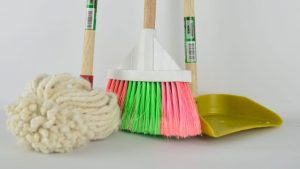This post was last updated on August 12, 2021 by Preethi Sukumaran
As a modern factory making traditional, purely natural products made ONLY from herbs, several challenges come our way. One such challenge we faced is on how to safely and effectively fumigate the factory without using dangerous chemicals. Is there such a thing as a purely herbal fumigation? Read on for more answers.
The problem with conventional pest control
Many conventional methods of pest control and cleanliness cannot be used at Krya as they involve powerful, extremely dangerous chemicals that kill animals, can potentially injure staff, and have no long term effects on pests / insects.
Plus, the use of these nasty chemicals significantly impact air and water quality as their residues leave the factory. So a part of our work is in finding humane and effective ways of keeping pests out of the factory. Also, we work on formulations that can keep our hygiene and cleanliness levels in the factory high so that our products are uncontaminated by fungal microorganisms.
Controlling Rodents naturally using herbs : a Krya experiment
After a great deal of trial and error, we developed a rodent repelling oil at Krya. Rodents can potentially find our factory extremely attractive, given our large use of edible , high quality organic food grains. Through a judicious combination of keeping our premises tidy, wrapping our food grains in several layers and shutting all possible entry points into our factory, we have managed to dissuade rodents. For the persistent ones, we have our rodent repelling oil.
The Krya rodent repelling oil uses many traditional oils and herbs given in the texts including “Karpura” (camphor) which irritate and repel rodents. So every 2 days and on Saturdays, our team paints a layer of this rodent repelling oil around all our RM and at all entry and exit points.
Our products do not kill rodents, pests and animals. But they repel. We utilise an important principle when we formulate these products : we train the animals and insects to recognise that our surroundings are unpleasant and unrewarding to them. By repelling and not killing them, we encourage communication between the rodent population or the insect population where early sufferers pass on the message to the rest of the population. Hence, in a few generations, we are able to train these living creatures to stay away from our factory premises.
Repelling cockroaches naturally: the Krya way
We use a similar principle in our soon to be launched cockroach repellant oil and our floor cleaner. The cockroach repellant oil can be painted onto kitchen cabinets and cupboards. We have seen through live consumer research how consistent application (about once in 3 weeks or so), brings down roach infestation to near zero levels without introducing any toxic chemicals in the home. We simply use herbs and plant oils to train them to stay away.
The Krya cockroach repellant oil contains 17 ayurvedic herbs and oils that have been carefully selected to cleanse, purify the air and repel insects naturally. This is an oil concentrate which can be used 2 ways: It can be mixed in water and sprayed over surfaces like the kitchen platform at night. It can also be used in its oil concentrate form and painted onto the edges of cupboards, etc.
In its concentrate form the Krya cockroach repellant oil repels cockroaches for upto 3 weeks at a time depending upon the size of the infestation. All the herbs used are safe, natural. Many of the herbs are edible.
Herbal Fumigation: using plant resins, leaves and roots
Fumigation is another suggested best practice in many factories. This is usually done to dissuade mould growth on walls, especially in humid or damp conditions. Typically, fumigation is done with the highly potent and potentially carcinogenic Formaldehyde. This procedure is so dangerous for human health that it is usually advised to be done during a weekend where a day is spent in simply airing the place after the fumigation so that there are no health ill effects for the staff.
Fumigation is a good practice to follow in humid cities to keep moisture levels low. BUT, fumigating with Formaldehyde creates a whole set of other, unnecessary problems. So , we turned to our texts for inspiration and advice.
Herbal fumigation using plant resins and herbs is a traditional Ayurvedic practice documented across all our texts. It has been suggested in childcare, for the sick, in hospitals and also at home to cleanse the air. Today we only use agarbattis and Dhupa in a limited manner during poojas and holy rituals.
But traditionally agarbattis, dhupas and compacted herb powders were powerful fumigation tools. Fumigation was even used to deliver medicines in breathing disorders, to bring down certain fevers and of course to cleanse and purify the air. Fumigation was also suggested to purify bed linen and clothing among babies, the elderly and patients who are vulnerable to disease.
Please note that the agarbattis and dhoop sticks we use today in our homes bear NO resemblance to traditional ayurvedic agarbattis and dhoop sticks. Most agarbatti manufacturers use coal as the base for these products which is NOT approved in Ayurveda. This fine coal dust negatively impacts the lungs of employees who work in these factories causing respiratory issues. Also, today to provide strong fragrance, agarbatti sticks are dipped in synthetic fragrance oils. Burning these releases many VOCs into the air, many of which are not fit for human consumption. Hence, you may find a warning asking you to burn agarbatti in an empty room and to air out the room before human beings use it!
Many different formulae exist in traditional texts to make agarbattis and dhoop sticks. Dried cow dung is a common base. We can also make the base from a mixture of herbs, plant resins and specific oils and fats like ghee. The choice of material depends upon the purpose and the ancient texts are extremely wide ranging in their choice of material.
To fumigate the Krya factory, we have stuck to a simple formula to make our Fumigating dhoop sticks. We have used Rakshoghna herbs like Neem, Eucalyptus and Lemongrass. These herbs are extremely cleansing and purifying and help clarify the air around them.
In a slightly esoteric sense, Ayurveda also suggests adding uplifting and vata removing herbs in fumigation formulations. The Acharyas tell us that mental depression, anxiety and gloominess is caused by imbalanced vata dosha. So the burning of certain herbs helps dispel this darkness. So our formulation also contains herbs like “Abhaya” (Haritaki – without fear), Vacha (Sweet flag). We use a combination of insect repelling, clarifying and purifying fats and oils to bind our herbs together including Tamanu oil which is an excellent flying insect repeller.
Our dhoopa stick when burned has the same fragrance one would associate with a yagna and homa, perhaps due to the use of similar materials. There is no cloying, synthetic or over sweet fragrance. But the air feels clearer and much better than before when it is done.
To sum up: pest control CAN be safe
Most of us despair at the thought of using extremely powerful, dangerous synthetic products around our home. We wonder if any safe, natural herbal alternatives exist. We further question whether these safe, natural alternatives can actually be effective.
We share this post today simply to tell you that safe natural alternatives DO exist. There is no need to continually use dangerous chemicals around the home.







Is your repellents availabl for sale?
I regularly use Krya goodies.
Not yet Uma. Will update once they are.
Please tell how to make natural and herbal dhoop ourselves
Appreciate the attention to detail. This was very enlightening to read 🙂 look forward to the launch of your repellent oils. Thank you ?